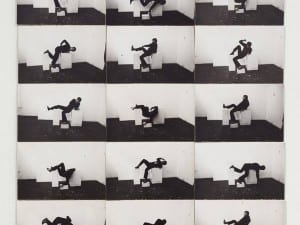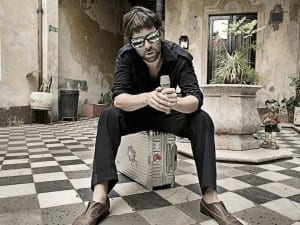Boo Mitford is an artist who comes from a famous line of creative people; the descendant of the famous Mitford sisters is finally releasing her work onto the London art scene after 10 careful years working behind closed doors. Mitford is no usual painter, with a preference for spoons over brushes and an abiding love of the “capricious nature” of paint and colour. We sat down with Mitford in her Notting Hill home to talk paint, artistic process and future plans before the opening of her exhibition Chaos Contained.
A: Chaos Contained, what a great title, how did it come about?
BM: I think it kind of sums the paintings up, because when you articulate the colour, circles and movement you realise it’s the circle that’s holding it all together. The circle is the rigid bit and if you didn’t have that the eye would find it very hard to read anything. The title reflects what’s happening in the shape; the way the paint is mixing and fighting. You also have the colours playing and blending with each other. All of this activity is confined in the circle, so that’s why it’s called Chaos Contained.
A: Were you always interested in art from a young age or was it something you came to love over time?
BM: Yes always. I think that’s one of the luckiest things if you just know what you want to do, because then you love it. Everyday you just wake up and think “right I’ll just crack open another bottle of paint”. For my older sister it was that she knew she wanted to be a doctor, and then you just get going, like running, and just go in that direction.
A: So what would you say is one of the fundamental elements of your work?
BM: I think colour is my obsession. It started with colour and I found paint is just the most fantastic medium to work with for colour. There’s nothing more exciting than having a pot of paint sitting there, it’s up to you to make something of it and then with all the different colours… I try to use colours in my paintings so that they either really fight or they become harmonious. So take something like the colour wheel, I did a big experiment once moving through the yellows to the oranges and that’s very lovely to watch. Then you go to the other extreme and you get a huge mix. So I use the circle as a way of controlling the area, I haven’t chosen it for anything other than a way of containing what’s happening. I tend to say my work at the moment is circles, colour and movement. Movement is really important because if you took out all of this that’s happening it wouldn’t be so exciting. Then you have the final signature at the end, “the flick”, and there are just fantastic things happening. So I’ll put a pallet of colours together, then I experiment, you know if I put a darker colour on the outside it has a completely different effect. So you have to just keep going until something amazing happens.
A: One of the appealing things about your practice is that you tend to work on all manner of scales – but do you prefer producing at the size you started out at?
BM: I do because you don’t get the nuances of all this twisting as much when you work on a big scale, because you have more molecules in the paint they don’t hold together in the same way. Paint is incredibly heavy; I had no idea until I started doing these larger ones just how heavy it is. A cubic square metre of water weighs a tonne so if you think of that in terms of paint that’s really heavy. So when you’re working on a big canvas different things happen: you’ve got the scale of it and all that colour coming at you. While at the small size you’ve got more intricate things. But no you can’t replicate, because of the molecules, you can’t replicate what happens small, you can’t just copy it completely by enlarging it.
A: You have a very unique technique. Is it something you’ve developed since art school or something that’s come to the fore more recently?
BM: I would say it started about 15 years ago. It was just the most perfect model on which to play. First of all I did a year’s sabbatical where each month I created the paintings and then I’d meet with a friend and present a book. I’d make a book at the end of every month. Then when you’re wondering what you did that month you’ve got a physical record of everything you’ve created. It forces you into putting things down and so at the end of the year I had 12 books. That alone was really inspiring. Plus you can really see the progress. One month I was trying with gold and that was great. Each time it was different and we’d meet in a different part of London that neither of us had been to as well so it was a combination of things. Then I was told to do some bigger. I’d perfected the technique by then, but taking that larger meant I had to move to work with acrylic. When you’re working mounds of paint drying sort of like dunes but it can’t crack, it’s ugly, it needs to look beautiful and have a good surface. I started with household paint so that change was a great experimentation of moving into another medium. You get these wonderful textures and mounds when you’re working with acrylic.
A: You use spoons to create your works, how did that come about, was it simply experimentation?
BM: I think it was the paint. The paint will only respond to how you manipulate it and sometimes it gets the better of you. But you’ve got to make it do what you want and it responded to spoons rather than a paintbrush. It was good with its fluidity.
A: Are the spoons going to be on display?
BM: Don’t you think they look like tulips? They’re happy spoons aren’t they? They’re really exciting and you can see the colours. Each one you could make a painting from those colour combinations. I don’t know about the spoons but I’ll definitely have my aprons. They’re lovely. I have a morning and an afternoon apron because you have to keep everything very clean as you’re doing it. Paint always wants to get somewhere and do something and you have to keep a very strict hold on what’s going on.
A: Yes your work excels at that; it’s at once posed but keeps that element of chance and randomness, do you find it tricky to keep the balance between the two?
BM: Yes, I think the biggest thing with this work though because of all that randomness is the editing. So I might do 30 or 40 paintings and if they don’t capture something then I just destroy them. To get a good one I have to go through many stages, experimenting with colour and what’s exciting. But, “the flick” at the end can sometimes just destroy a painting. But going up to these larger ones you can’t just destroy that number of paintings. They also take up to eight or nine months to produce, at this size. So although they look, or they should look, as if they’ve been created in a moment, without the movement they lose energy.
A: You’ve worked mainly as a graphic designer, do you think that’s affected the way you approach painting?
BM: Originally yes, I went to St. Martin’s – when it was just St. Martin’s then –and paint was always key for me. I kept being drawn towards it, but equally I just loved graphics. I became a graphic designer, but quite often when I was designing I would use painting in my work. They relate very closely so it would often come through and you can use lots of colour in graphics, so that was great.
A: What or who inspires you? Are there any particular artists you admire?
BM: Cy Twombly is one of my favourites. Soutine, Basquiat and Yves Klein are all an inspiration. There’s a lot of amazing combinations out there – you only have to look at cartoons. I often freeze-frame and think “wow look at that”, or torn newspapers, man-made things. Some of the best inspirations are just little old ladies in the street – their combinations are just incredible. The best thing is to try and articulate that sensation by writing something down. It’s quite a good way of forcing yourself to understand why you find something so exciting – what is it? Because often you can walk past fashion houses and shops like that and you say “I’ve seen that combination before” can’t they do something more interesting? So yes man-made stuff I’d say.
A: What are your plans for the future? Now that you’ve contained chaos, where do you go from there? Is it a long way off yet?
BM: No because it’s been bubbling away for a while now. I mean you can see the other things I’ve been doing along the way because when you’re using paint things happen and you do things, you see something, and you think “that’s exciting I could pursue that”. After Chaos Contained, after all this control, I’m going to go landscape. So it’s going to be more infinity lines. I know where it’s going. It’ll be quite different and I won’t be afraid of working in scale. But colour will always be fundamental to all of it; colour and movement.
Chaos Contained Paintings by Boo Mitford 2005 – 2015, 15 May – 12 June, 150 Great Portland Street, Fitzrovia, London, W1W 6QD. Find out more at www.boomitford.com.
Thea Hawlin
Credits
1. Seaside, Boo Mitford.





